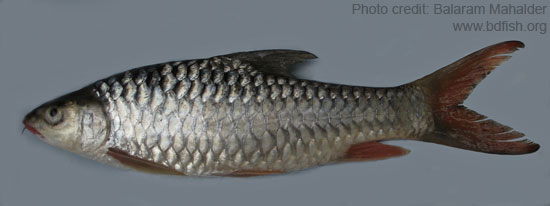
Systematic position
Phylum: Chordata
Class: Actinopterygii (Ray-finned fishes)
Order: Cypriniformes (Carps)
Family: Cyprinidae (Minnows and carps)
Genus: Tor
Species: T. tor
Common/local names
English: Tor barb and Tor mahseer
Bangladesh: Mohashol (মহাশোল), Mohal (মহাল), Tor mahaseer (টর মহাশির)
India: Burapatra, Leopithia, Pukkiranga, Pithia, Mahasol, Mahaseer (Talwar and Jhingran, 1991).
Synonyms
Barbus megalepis McClelland, 1839
Barbus tor (Hamilton, 1822)
Cyprinus tor Hamilton, 1822
Puntius tor (Hamilton, 1822)
Tor hamiltonii Gray, 1834
Tor mosal mahanadicus David, 1953
Distribution: Bangladesh, Pakistan and India (Yadav, 1997). Bangladesh, India (sub-Himalayan range, Ganga and Narbada river systems) and Pakistan (Talwar and Jhingran, 1991).
Conservation status: Critically endangered in Bangladesh (IUCN Bangladesh, 2000).
Morphology: The body is stout, elongated and compressed. The ventral profile is more arched than dorsal profile. Head is comparatively smaller and pointed. Mouth small and inferior. Eyes visible from below the head. Lips are thick and fleshy, running at angles of mouth. Barbels two pairs and scales large.
Lateral line scales 25-26 (Rahman, 1989) and 22-27 (Talwar and Jhingran, 1991). A scaly sheath is present on the base of dorsal and the last unbranched ray of dorsal fin is comparatively strong, smooth and osseous. Caudal fin is deeply forked. Color of the dorsal side is dark grey. Golden to pinkish on flanks and abdomen is silvery with slightly golden tinge. Below the eyes is light yellow. Dorsal, pectoral and anal fins are reddish yellow in color.
Fin formula
D. 12 (3/9); Pi. 16-17; P2. 9; A. 7 (2/5) (Rahman, 1989)
D iv 8; A iii 5; P i 14-17; V i 8 (Talwar and Jhingran, 1991)
Maximum lengths and weight: 52 cm (Rahman, 1989) and 15 cm (Talwar and Jhingran, 1991).
Weight of this fish does not depend on age, rather it depends on the size of the water body where it lives (Talwar and Jhingran, 1991).
Habitat and Niche: Found in freshwater bodies ( mainly hill streams ). Niche is middle layer of a water body (Yadav, 1997). According to Rahman (1989) this fish is found in Kangsha, Someswari, Para rivers and Karnafuli reservoir (near Chittagong Hill Tracks) in Bangladesh. Tor tor grows better in a river with rocky bottom.
Food and feeding: Voracious feeder ( mainly take higher submerged plants) (IUCN Bangladesh, 2000).
Breeding: Breeds occur during August-September till December (Talwar and Jhingran, 1991). In the time of breeding, adults ascend upstreams after the rains begin (IUCN Bangladesh, 2000). Jhingran (1980) reported that younger ones breed earlier in the season than the older ones.
Two types of breeding behavior have been observed. In one, female swim slowly along the side of the stream while male follows close behind fertilizing the eggs. In the second, they excavate a small hollow in the gravel substrate where the female diposits eggs and fertilized by the male (IUCN Bangladesh, 2000).
Importance: Used as tasty food fish. This species can be utilized in biological control of water weeds (Tilak and Sharma, 1982). It is a sporting fish and also very profitable for angler (Talwar and Jhingran, 1991). This species command a good market price and consumer demand.
__________________________________________________________________
REFERENCES
David A. 1953. On some new records of fish from the Damodar and the Mahanadi River systems. Journal of the Zoological Society of India v. 5 (no. 2): 243-254.
Gray JE. 1833. Illustrations of Indian zoology; chiefly selected from the collection of Major-General Hardwicke, F.R.S., …. 20 parts in 2 vols. Illustrations of Indian zoology; chiefly selected from the collection of Major-General Hardwicke, F.R.S., …. Pls. 1-202. [For dates of parts see Sawyer 1953. Fishes on pls. 84-99 in vol. 1 and 88-102 in vol. 2.]
Hamilton F. 1822. An account of the fishes found in the river Ganges and its branches. Edinburgh & London. An account of the fishes found in the river Ganges and its branches.: i-vii + 1-405, Pls. 1-39.
IUCN Bangladesh. 2000. Red book of threatened fishes of Bangladesh, IUCN- The world conservation union. xii+116 pp.
Jhingran AG. 1980. In: Talwar PK and Jhingran AG. 1991. Inland Fishes of India and Adjacent Countries, Vol. I, Oxford & IBH Publishing Co. Pvt. Ltd. New Delhi-Calcutta, pp. 309-310.
McClelland J. 1839. Indian Cyprinidae. Asiatic Researches v. 19 (pt 2): 217-471, Pls. 37-61.
Rahman AKA. 1989. Freshwater Fishes of Bangladesh, 1st edition, Zoological Society of Bangladesh, Department of Zoology, University of Dhaka, Dhaka-1000, p. 136.
Talwar PK and Jhingran AG. 1991. Inland Fishes of India and Adjacent Countries, Vol. I, Oxford & IBH Publishing Co. Pvt. Ltd. New Delhi-Calcutta, pp. 309-310.
Tilak and Sharma. 1982. In: Talwar PK and Jhingran AG. 1991. Inland Fishes of India and Adjacent Countries, Vol. I, Oxford & IBH Publishing Co. Pvt. Ltd. New Delhi-Calcutta, pp. 309-310.
Yadav BN. 1997. Fish and Fisheries, Daya Publishing House, 1123/74 Deva Ram Park, Tri Nagar, Delhi 110035, India, pp. 23-317.
Visited 6,633 times, 1 visits today | Have any fisheries relevant question?
